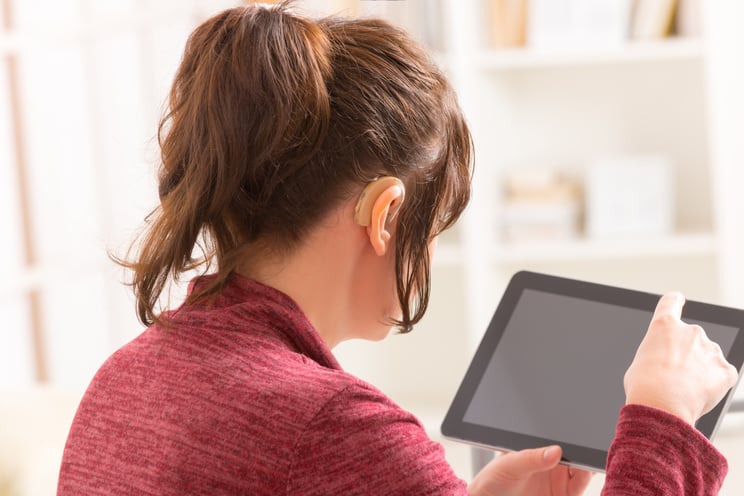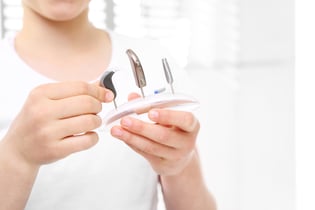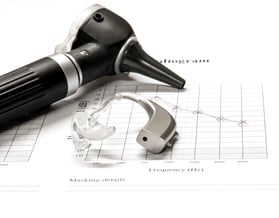 One fifth of Americans age 12 and over have reported hearing loss to some degree, according to a study by Hamilton Hearing, LLC. As of 2011, over 30 million people have reported hearing problems and 48 million people that have lost hearing in one ear, not including the 1,000 infants born with hearing problems.
One fifth of Americans age 12 and over have reported hearing loss to some degree, according to a study by Hamilton Hearing, LLC. As of 2011, over 30 million people have reported hearing problems and 48 million people that have lost hearing in one ear, not including the 1,000 infants born with hearing problems.
Hearing aid dealers now offer a wide variety of products that can help the hearing impaired. This list includes customizable hearing aids, support for kids and the latest in hearing aid technology. Here are a few of the outstanding hearing aid manufacturers as well as the seven most common types of hearing aids.
Hearing Aids for All
According to Starkey Hearing Technologies, there are seven different types of hearing aids with different levels of support offered.
The first hearing aid for mild hearing problems is a sound amplifier. The technology is simply called AMP and is designed to be invisible in most ears. This easy-to-remove aid was designed for first-time hearing aid users. The  mild to moderate option is the completely-in-canal (CIC) option, made to cover the ear canal, virtually undetectable, and custom-made for each user. The in-the-canal (ITC) hearing aid treats moderate to mildly severe problems and is also custom made. This model fits into the customer’s ear canal, blending in with the rest of the ear.
mild to moderate option is the completely-in-canal (CIC) option, made to cover the ear canal, virtually undetectable, and custom-made for each user. The in-the-canal (ITC) hearing aid treats moderate to mildly severe problems and is also custom made. This model fits into the customer’s ear canal, blending in with the rest of the ear.
For customers with a need for greater support, the behind-the-ear (BTE) option is the most popular. BTE aids come in a discreet, customizable style. This option connects a wire, the “receiver,” into the ear while the part behind the ear process everything. The receiver acts as a loud speaker in the ear while the processor sits behind it.
Another option is the receiver-in-canal model, which is pretty similar to the BTE option except that the receiver attaches in the ear canal. For mild to moderately severe hearing problems, invisible-in-the-canal products (IIC) are best. These devices cannot be seen since the hearing aid fits in the ear canal and the receiver is a tiny wire and microphone.
Leaders in Hearing Aid Manufacturing
The top hearing aid manufacturers are:
- Starkey
- Phonak
- Unitron
- Oticon
- Signia
- ReSound
- Widex
 Among the many hearing aids Starkey offers, the two most popular are the Halo and Muse aids. The Halo aid can wirelessly connect to an iPhone and offers GPS geo-tagging that adjusts to the wearer’s preferences and location. This product line streams media and phone calls straight to the hearing aid. Halo and Halo 2 assist the RIC and BTE hearing aids.
Among the many hearing aids Starkey offers, the two most popular are the Halo and Muse aids. The Halo aid can wirelessly connect to an iPhone and offers GPS geo-tagging that adjusts to the wearer’s preferences and location. This product line streams media and phone calls straight to the hearing aid. Halo and Halo 2 assist the RIC and BTE hearing aids.
The Muse aid also streams media and phone calls, and offers the “Surflink” cell phone transmitter, which allows Muse to wirelessly become a hearing aid remote, phone transmitter and an assistive listening device. The Muse aid covers a wider range of hearing aids that are compatible with ITE, ITC, BTE, CIC and RIC.
Phonak is the leader in pediatric hearing solutions. For hearing loss in children, Phonak offers the customizable SkyV and offers better speech understanding for kids. The SkyV is also waterproof and sweat and dust resistant, allowing for maximum socialization and play. This line comes in the RIC and BTE hearing aid.
Out of Canada, Unitron creates hearing aids that emphasize the patient’s individual comfort, needs, aesthetics and functionality. The Moxi line has options based on size and what level of technology is needed. Moxi offers 50 percent more accurate speech recognition while the Moxi R has a rechargeable battery.
 Known for its BrainHearing Technology, Oticon provides wearers with advanced options, including the OPN hearing aid. This hearing aid offers a 20 percent noise reduction rate and has shown 30 percent better speech understanding. Furthermore, it allows a greater scope of listening, allowing the brain to capture the intricate sounds of the wearer’s environment and focus on what it wants to hear.
Known for its BrainHearing Technology, Oticon provides wearers with advanced options, including the OPN hearing aid. This hearing aid offers a 20 percent noise reduction rate and has shown 30 percent better speech understanding. Furthermore, it allows a greater scope of listening, allowing the brain to capture the intricate sounds of the wearer’s environment and focus on what it wants to hear.
The first brand of hearing aids to integrate Bluetooth technology was Signia, formerly Seimens hearing instruments. This manufacturer now includes hearing aids that wirelessly connect to TVs, MP3 players, DVD players and more. The Signia primax hearing aid is known to reduce the amount of effort it takes for the wearer to listen clearly. The most popular aid is the Cellion primax, a rechargeable option that has a Micro USB charging port. This is a RIC hearing aid, treating wearers with moderate to severe hearing problems, and reduces the amount of background noise one might hear.
ReSound might be the most affordable manufacturer among the leaders, as its starting price is listed at $500 less than the competition. Its most popular model, the LiNX 3D, offers levels of power that vary for the intensity of the wearer’s need (mild, moderate, severe) and a customizable design for comfort. It also connects to an iPhone app, where phone calls, FaceTime chats, music and other media can be directly streamed to the hearing aid.
Powered by a microchip processing platform, Widex considers their hearing aids to be “sleek micro-computers for your ears.” Their BEYOND hearing aid is an advanced aid that connects to iPhones. This features a GPS enabler, where the wearer chooses their favorite locations and BEYOND will automatically adjust to the listening environment. The iPhone app will also show the battery life of the hearing aid and control over listening preferences and volume.
Service by Hearing Aid Dealers
The average cost of all hearing aids mentioned above is $2,000 for one hearing aid, or $4,000 a pair. Sixty-eight percent of people with hearing loss said that getting support was not financially feasible for them. Furthermore, while 95 percent of American’s with hearing loss could be treated with hearing aids, only 30 percent were using hearing aids as of 2015.
 Hearing aids are not typically covered by most health insurance plans. Some private plans cover the cost of hearing tests or half the cost of aids, but with prices ranging from $1,500 – 3,500 each, hearing aids are an expensive support system. Over one million children under the age of 18 have hearing loss while the lifetime cost to children with hearing problems increases by $1 million dollars in special education, health complications and lost wages. For adults, hearing loss contributes up to $30,000 in lost income per year in one household!
Hearing aids are not typically covered by most health insurance plans. Some private plans cover the cost of hearing tests or half the cost of aids, but with prices ranging from $1,500 – 3,500 each, hearing aids are an expensive support system. Over one million children under the age of 18 have hearing loss while the lifetime cost to children with hearing problems increases by $1 million dollars in special education, health complications and lost wages. For adults, hearing loss contributes up to $30,000 in lost income per year in one household!
The Hearing Aid Assistance Tax Credit was introduced to the senate earlier this year, and could offer a $500 per ear non-refundable tax credit every five years if passed. While this would help the cost of a hearing aid, a customer would still be left with half the cost or more.
CrossCheck offers a versatile payment option that allows hearing aid dealers to help more clients afford expensive hearing aids.
Hearing aid dealers using the Multiple Check program accept 2 – 4 checks from clients to cover the cost of hearing aids without the need for existing lines of credit or applying for CareCredit. Dealers receive guaranteed funding from CrossCheck as each check is deposited on dates chosen by clients over a 30-day period. There is no extra cost to consumers, and they receive needed support without delay. Download our free guide to Multiple Check to learn how it can help you help even more clients.



